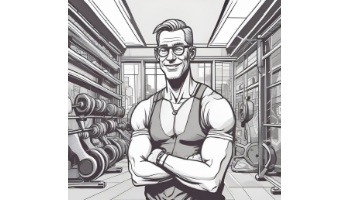By Keith Allaway
 At eight years old I made the first of many poor life decisions. Standing in the middle of our kitchen I took a stab at establishing some independence, telling my mother, who was lecturing me over some minor infraction, that she should “get stuffed.” It became immediately clear that I had made an egregious error. The look of thunderous outrage that immediately came over my mother’s face could lead to only one conclusion—that I should flee for my life. This was a decision that would, in short order, lead to an important encounter with a very relevant subject: pain.
At eight years old I made the first of many poor life decisions. Standing in the middle of our kitchen I took a stab at establishing some independence, telling my mother, who was lecturing me over some minor infraction, that she should “get stuffed.” It became immediately clear that I had made an egregious error. The look of thunderous outrage that immediately came over my mother’s face could lead to only one conclusion—that I should flee for my life. This was a decision that would, in short order, lead to an important encounter with a very relevant subject: pain.
After my misguided statement to my mother, I made a speedy exit out the kitchen door and down the garden path toward the freedom of the open field on the other side of the fence. In my haste, I had forgotten that this fence had a line of barbwire across the top. As I attempted to scale it I lost my footing, fell back and impaled my left knee on the wire, finally coming to rest upside down. Hanging there I saw my mother, arms still folded, strolling down the garden path, finally stopping about a foot away. Rather than help me down from my precarious and painful position, she decided to continue her unfinished lecture, making it very clear who held the power in this relationship. Only after a tearful apology was delivered did she help me down and back to the kitchen for palliative care consisting of a bandaid and a biscuit. Along the way, I was told to think hard about my behaviour.
I offer this anecdote as an example of a tonal and societal shift in how we deal with pain in our everyday lives, a conversation that I have almost daily as a personal trainer/strength coach. While I am in no way suggesting that we return to the barbarousness of the past, there is definitely a hint that we, as a culture, have lost some of the resilience of generations past when it comes to pain, and this may come with a cost.
The Subjective Nature Of Pain
Firstly, what is pain? In its simplest terms, it is a defensive mechanism against bodily harm. Should you put your hand in a fire, receptors in the skin send a message to the brain. The brain then interprets the level of jeopardy, sends an “ouch” signal appropriate to the threat level, and finally causes you to pull your hand away. These basics are simple enough, but the simplicity ends there. In spite of all our technological advancements there is no objective measure for pain. There are well over fifty recognized pain scales used in various clinical settings, all fundamentally subjective in nature. What this means is, we have a hard-wired system that we are unable to accurately measure and whose inherent vagueness puts any professional in the field of pain mitigation at a disadvantage from the start. With no objective way to measure pain, professionals have no reliable way to measure their own interventions. More than that, alongside the difficulties presented with objectively measuring the physical mechanics of pain, there also appears to be a large psycho-social element that effects how individuals express their experience of pain. In other words, while two people might both experience a pain sensation as extreme, they may have different levels of tolerance for that same phenomenon.
Can We Be Free Of Pain?
What I am particularly interested in here is the latter part of the reality of pain—the psycho-social element. Historically, as suggested by my childhood anecdote, there was a time when pain was an expected part of life, something that we should endure like we would any other of life’s inconveniences. It was not until the late 1960s and into the 1970s that medical professionals began to question this inevitability. At that time, pain, alongside all of the other advances of the modern world designed to rid us of inconveniences, became a focus area for better drugs and treatments, each offering the idea that pain and discomfort can be reduced or removed. No one, the idea was, need suffer so.1
While this sounds good in theory, I suspect it comes with unintended consequences that we should consider. Take for example, a 2016 study conducted by the Institute for Health Metrics and Evaluation at the University of Washington which looked at a measurement it called “Disability Adjusted Life Years.” This number was derived by combining years lost to premature death measured against predicted life expectancy with years spent with a debilitating illness. Unsurprisingly, the number one cause of lost productivity in rich countries was heart disease. What might surprise us though is the number two, which was neck and low back pain. What is interesting here is that this, unlike heart disease, is a subjective experience and as such, could be influenced by psycho-social factors. Indeed, if we observe that back pain was listed in a lowly twelfth place during the 1990s, we might begin to suspect that it is not so much that this kind of pain has increased, but rather that our tolerance of it has decreased. I would argue, in fact, that it is quite possibly representative of a generational shift with regards to our acceptance of the discomfort of back pain.
Don’t Give Too Much Power To Pain
The idea that our acceptance of pain may have changed is worth raising and discussing, because how we approach pain has repercussions in our daily lives. Especially in light of the opioid crisis, we should be asking ourselves what place pain—particularly the kind that we would expect from normal, age-related wear and tear—should have in our existence.
My own twenty years of experience have shown me that too often we are over-medicated and over-pathologized. We must be able to navigate the difference between pain that is transient or the consequences of minor injury—which will likely resolve on its own given a little time—and the kind that is indicative of something more serious. And even then, some chronic conditions, such as arthritis, can be quite debilitating but are never going to be cured. In that case it becomes my job to make a person as strong and physically resilient as possible in order to mitigate the worst effects. I am not necessarily saying that we should become like the knight in Monty Python and the Holy Grail, who declares after having his arm hacked off that it is “only a flesh wound”, but I am suggesting that we may need to rediscover a bit of our past resilience. We must understand that a little pain and inconvenience is sometimes a part of life.


